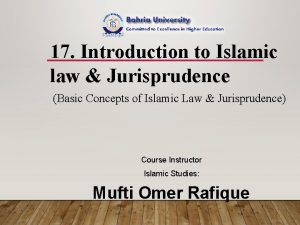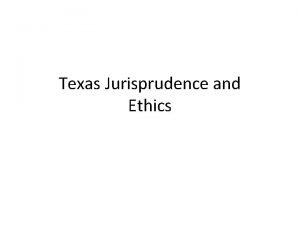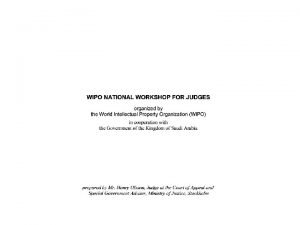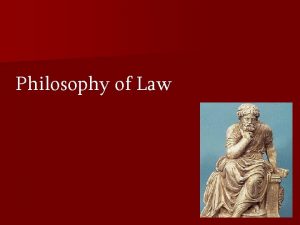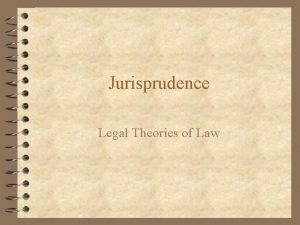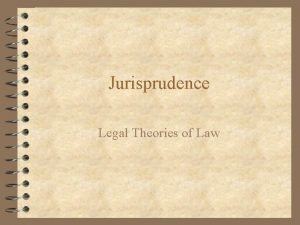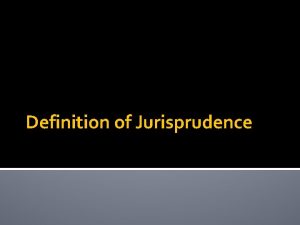Concept of Right and Duty Course Jurisprudence LAW











- Slides: 11

Concept of Right and Duty Course: Jurisprudence (LAW 350) B. A. LL. B. (Hons. ) 6 th Semester

Concept of Right and Duty: Introduction § The development of society is credited to the constant evolution of law. Everyone in the society has certain rights and duties obligated towards one another. § A right and duty are the pillars of law, and are protected and enforced by law and one cannot long talk on a legal topic without using the words right and duty or some synonyms. § Human beings spend much time in claiming about his “rights”, asserting their existence, complaining of their violation, describing them as present or future, vested or contingent, absolute or conditional, perfect or inchoate, alienable or inalienable, legal or equitable, in rem or in personam, primary or secondary, moral or jural, inherent or acquired, natural or artificial, human or divine. § Rights and duties have a close relationship and both are inseparable. Both are existing side by side. One can say that right and duty are the two sides of the same coin. § These are two basic concepts without understanding these you can not understand concept of law.

Concept of Right § ‘Right’ in its ordinary sense means standard of permitted action within a certain sphere. § In legal sense, it means the standard of permitted action by law. Such permitted action of a person is known as his legal right. § A legal right is different from a moral or natural right. A legal right is an interest recognized and protected by a rule of legal justice. Moral or natural right means an interest recognized and protected by a rule of natural justice. It is an interest the violation which would be a moral wrong, and respect for which is a moral duty. § The difference between these two lies in the sanction behind them. The violation of a legal right is redressed by the state whereas behind the moral rights there are only moral and social disapprobation. § Moral Right and Legal Rights: Prof. Holland distinguishes between legal right and moral rights as: If the pubic opinion would view with approval or at least with acquiescence, a person carrying out his wishes, with disapproval any resistance made to his doing it, then he has a moral right to carry out his wishes. § If state protects him in so carrying out his wishes, and will compel such acts or forbearance on the part of other people, as may be necessary in order that his wishes may be so carried out, then he has a legal right to carry out his wishes.

Meaning of Legal Rights § When we discuss concept of right, we generally discuss concept of Legal Rights. § John Salmond defines right as an “interest” recognised and protected by a rule or justice. He says, for an interest to be regarded as a legal right, it should obtain not merely legal protection but also recognition. Example- law prohibits cruelty against animals, so it protects interest of animals, but animals do not possess any legal rights as there is no recognition of interest of animals. § Gray defines legal right as that power which a man has to make a person or persons do or refrain from doing a certain act or certain acts, so far as the power arises from society imposing a legal duty upon a person or persons. He further states that the right is not the interest itself, it is the means to enjoy the interest secured. § Supreme Court of India explained concept of legal right in the case of State of Rajasthan v. Union of India (1977) as: legal rights are correlatives of legal duties and are defined as interests whom the law protects by imposing corresponding duties on others. But in a generic sense, the word ‘right’ is used to mean an immunity from the legal power of another, immunity is exemption from the power of another in the same way as liberty is exemption from the right of another, immunity, in short, is no subjection.

Theories of Legal Rights: § There exist two main theories of legal rights – 1. Will Theory, and 2. Interest Theory. § Will Theory: It states that right is an inherent attribute of the human will. The purpose of the law is to allow the free expression of human will. This theory was advocated by scholars like Hegel, Kant, Hume etc. The subject matter is derived from human will. § Austin, Holland Pollock define rights in terms of will. According John Locke the basis of the right is the will of the individual. Puchta defined the legal right as a power over an object which by means of right can be subjected to the will of the person enjoying the right. • Despite its wide acceptance, there were many scholars who disagreed with it. Some of the criticisms were from Duguit who is opposed to the “will” theory. According to him the basis of law is the objective fact of “social solidarity” and not the subjective will. The law is to protect only those acts or rights which further “social solidarity”. He calls theory of subjective right as a mere metaphysical abstraction.

Theories of Legal Rights § Interest Theory: It was proposed by the German Jurist, Rudolf von Ihering. He defined rights as legally protected interests. Ihering does not emphasize on the element of will in a legal right. Foe him the basis of legal right is interest and not will. § The main object of law is protection of human interests and to prevent conflict between individual interests. These interests are not created by the state but they exist in the life of the community itself. § Salmond mentioned that enforceability is also an essential element. He says that rights are concerned with interest, and indeed have been defined as interests protected by rules of right, that is by moral or legal rights. § Salmond criticise it as it totally overlook element of recognition by state. Gray is of opinion that it is not interest itself rather a means of protection of interest. § Both these theories are not opposite to each other, it is rather a combination of both theories. Allen has tried to blend these two theories by pointing out that the essence of legal right seems to be, not legally guaranteed power by itself nor legally protected interest by itself, but the legally guaranteed power to realise an interest. Thus, it would be sensible to say that both will and interest are essential ingredients of a legal right. § Thus, Concept of Legal Right could understood in better way by understanding both theories.

Essentials of Legal Right § According to John Salmond, each legal right has five essential elements: § Subject of Right: Person vested with right, owner of right, person of inherence, holder of right (no need of determinate person). § Person of Incidence: Person under the obligation to obey or respect the right, person of incidence. § Contents of Right: Substance of right, context of right. It obliges a person to act or forbear in favour of the person who is entitled to the right. § Subject Matter of Right: It is something to which the act or omission relates, that is the thing over which a right is exercised. This may be called the object or subject-matter of the right. Some writers, although argue that there are certain rights which have no objects. § Title of the Right: Every legal right has a title, that is to say, certain facts or events by reason of which the right has become vested in its owner. Example: A buys a piece of land from B.

Theory of Duty § A duty is an obligatory act. It is something to do or abstain from doing in favour of another person. A man has a duty towards any matter that he is legally obligated to. § The term legal duty has been defined in the following ways – • Keeton defines duty as an act of forbearance which is enforced by the state in respect of a right vested in another and breach of which is a wrong. • Salmond defines duty as roughly speaking an act which one ought to do, an act the opposite of which would be a wrong. § A duty is of two kinds: Moral Duty and Legal Duty. Moral Duty: It is an act opposite to which is a moral or natural wrong. A duty may be moral but not legal or legal but not moral, or both at once. For example, the act of not wasting paper is our moral duty but not legal. § Legal Duty: It is an act, the opposite to which is a legal wrong. It is an act recognised as duty by law. Law ensures performance of legal duties and punishes disregard to this duty.

RELATIONSHIP BETWEEN RIGHTS AND DUTIES § Rights and duties are co-existent. Although there exists a difference in opinion whethere must be a right that correlates to the duty. § Rights and duties have a close relationship and both are inseparable. Both are existing side by side. One can say that right and duty are the two sides of the same coin. § Salmond says that there can be no right without a corresponding duty and vice versa. Every duty must be a duty towards a person or some person, in whom a correlative right is vested and conversely every right must be a right against some persons upon whom, a correlative duty is imposed. § Every right and duty has a bond of legal obligation. Austin has stated that rights are interdependent, not correlative, contrary to Salmond’s opinions. He has classified them into relative and absolute duties. § According to Austin, a state can have no legal rights against the subjects which are erroneous. All duties are relative just as all rights are. There can be no absolute duties and Austin’s classification of duties into absolute and relative duties is unsound. § A strong legal system shall consist of Legal Rights and Legal Duties like its two non-separable parts.

Hohfeld’s Analysis of Rights: This analysis is seen to understate the importance of rights for moral theory in two ways: as to liberty-rights, there is no sphere of freedom of action that it is the correlative duty of others to respect; and as to claim-rights, these appear to be no more than the reflex of a more basic, correlative duty.

References: § Raymond Wacks, Understanding Jurisprudence (New Delhi: Oxford University Press, 4 th edn. , 2015) § R. W. M. Dias, Jurisprudence (Gurgaon: Lexis. Nexis, 5 th edn. , 2013) § Arthur Corbin, “Rights and Duties”, 33 Yale Law Journal, 1924, at 501. § Joseph W. Bingham, “The Nature of Legal Rights and Duties”, 12(1) Michigan Law Review, 1913, pp. 1 -26. • https: //www. toppr. com/guides/legal-aptitude/jurisprudence/legal-rights-right-duty-correlation/ • https: //www. legalbites. in/rights-duties-jurisprudence/ • https: //shodhganga. inflibnet. ac. in/bitstream/10603/71969/3/03_chapter%201. pdf • https: //legaleasy. wordpress. com/category/concept-of-liability/ • https: //shodhganga. inflibnet. ac. in/bitstream/10603/71969/7/07_chapter%205. pdf • https: //www. wallstreetinstructors. com/ce/continuing_education/ethics/id 22. htm
 Basic concept of islamic law and jurisprudence
Basic concept of islamic law and jurisprudence Right product right place right time right price
Right product right place right time right price Right time right place right quantity right quality
Right time right place right quantity right quality The right man on the right place at the right time
The right man on the right place at the right time Safe harbor nursing texas
Safe harbor nursing texas Newton's first law and second law and third law
Newton's first law and second law and third law Newton's first law and second law and third law
Newton's first law and second law and third law Scope of jurisprudence slideshare
Scope of jurisprudence slideshare Importance of jurisprudence
Importance of jurisprudence Asha certification
Asha certification Objective of pharmaceutical jurisprudence
Objective of pharmaceutical jurisprudence Positivisme adalah
Positivisme adalah
